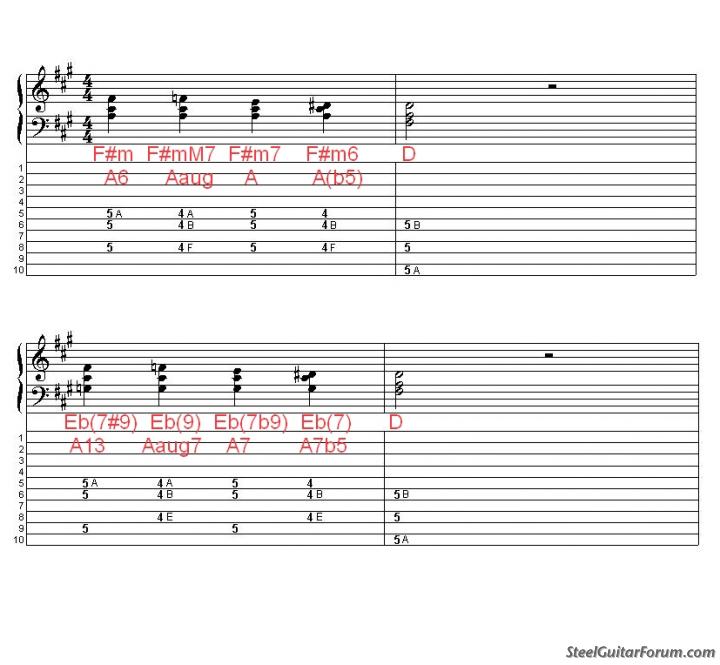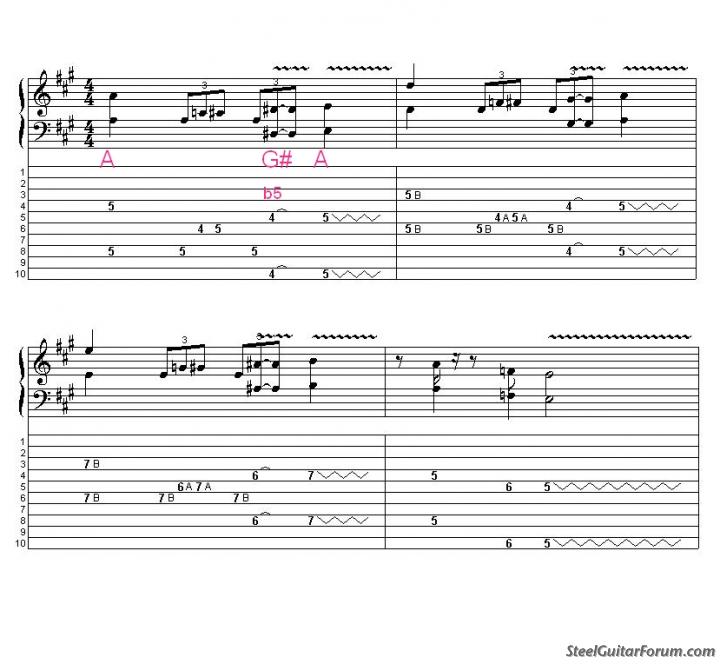Using the b5 as a target note to resolve to a 4 chord
Moderators: Dave Mudgett, Brad Bechtel
-
Bo Legg

- Posts: 3665
- Joined: 17 Apr 2007 9:43 pm
Using the b5 as a target note to resolve to a 4 chord
Lets just for the fun of it substitute an F#m chord for an Amaj chord. Then lets play the line of that F#m which is the theory of running the minor F#m to F#nM7 to F#m7 to F#m6 chords over the F#m chord that has been substituted for the A chord that’s hung around for a bar or so and then lets progress to a Dmaj chord by substituting an Eb7 which is the theory of a (b5)7 substituted for the A13b5 which is same as and is substituted for the F#m6.
Are we on target?
Are we on target?
-
Mike Neer

- Posts: 11452
- Joined: 9 Dec 2002 1:01 am
- Location: NJ
I understand what you're getting at, but using stricly F#m chords does not tell the whole story. A better way of harmonizing that descending bass line would be:
F#m to C#7/F to Em7 to Eb7 to D.
The C#7/F is simply a C#7 with an F in the bass.
F#m to C#7/F to Em7 to Eb7 to D.
The C#7/F is simply a C#7 with an F in the bass.
Links to streaming music, websites, YouTube: Links
-
Bo Legg

- Posts: 3665
- Joined: 17 Apr 2007 9:43 pm
Mike that is one great way to approach that run.
I was only thinking in terms of using the substitution of the line theory to show how I arrived at a descending run that targeted the b5 to accommodate a b5dom7 chord substitution resolving to the 4 chord.
The E9 steel doesn't lend it's self well to bass lines so I prefer the lower notes to remain constant and the higher notes form the ascending or descending chord runs.
Keeping the b3 and the 5 constant and the high notes descending from 1 through 6 of my F#m chord as shown below in the first example is usable but really takes off when I apply the b5dom7 substitution to the line theory as in the second example which keeps the 3rd and b7th of the chord constant and higher notes descending until the chord resolves into the 4 chord. This is the sound I'm trying to achieve.

I was only thinking in terms of using the substitution of the line theory to show how I arrived at a descending run that targeted the b5 to accommodate a b5dom7 chord substitution resolving to the 4 chord.
The E9 steel doesn't lend it's self well to bass lines so I prefer the lower notes to remain constant and the higher notes form the ascending or descending chord runs.
Keeping the b3 and the 5 constant and the high notes descending from 1 through 6 of my F#m chord as shown below in the first example is usable but really takes off when I apply the b5dom7 substitution to the line theory as in the second example which keeps the 3rd and b7th of the chord constant and higher notes descending until the chord resolves into the 4 chord. This is the sound I'm trying to achieve.

-
Mike Neer

- Posts: 11452
- Joined: 9 Dec 2002 1:01 am
- Location: NJ
Bo, I prefer to have moving harmony along with the descending line, so that's why I'd substitute some chords in there and get more of a story. There are many ways to approach it. I don't really know how all the E9 copedents work, but try this (it outlines all the moving harmony in my first example, but with the descending line in the melody):
[tab]
______________________________________
______________________________________
______________________________________
___________0F_________________________
____5A_____0_______3A_____4___________
____5______0_______3______4B__________
______________________________________
____5______________3______4E__________
______________________________________
______________________________________
[/tab]
I don't know, maybe it sucks. Unfortunately, I don't have a guitar with me.
[tab]
______________________________________
______________________________________
______________________________________
___________0F_________________________
____5A_____0_______3A_____4___________
____5______0_______3______4B__________
______________________________________
____5______________3______4E__________
______________________________________
______________________________________
[/tab]
I don't know, maybe it sucks. Unfortunately, I don't have a guitar with me.
Links to streaming music, websites, YouTube: Links
-
Bo Legg

- Posts: 3665
- Joined: 17 Apr 2007 9:43 pm
Mike sounds good. takes on a diminish flavor but a plain Eb7 to resolve to the D will always seem forced and unnecessary following some form of an A7 chord.
This whole topic is just an explanation of how a certain lick came into being by applying theory.
So here is the lick that was born of all this.
It is one of my favorite "what the heck was that lick" to irritate the band with.
So play an A7 and run to the the b5 and let it hang a little with a lot of vibrato and follow it with some form of an Eb7 without the root to resolve to D in this manor.

This whole topic is just an explanation of how a certain lick came into being by applying theory.
So here is the lick that was born of all this.
It is one of my favorite "what the heck was that lick" to irritate the band with.
So play an A7 and run to the the b5 and let it hang a little with a lot of vibrato and follow it with some form of an Eb7 without the root to resolve to D in this manor.

-
Earnest Bovine

- Posts: 8364
- Joined: 4 Aug 1998 11:00 pm
- Location: Los Angeles CA USA
You can keep the lower notes constant, and in fact you can just pick them once and let them sustain thru the entire first bar of both examples, by staying on fret 5. To get all 4 moving notes on the B string 5, you need the knee lever to lower 5 a half step. If you don't have the extra hardware put the open C natural in tune (F at fret 5) it probably won't matter in this case, unless tempo is really slow.Bo Legg wrote:.. really takes off when .. keeps the 3rd and b7th of the chord constant and higher notes descending
-
Greg Vincent

- Posts: 1034
- Joined: 4 Aug 1998 11:00 pm
- Location: Folsom, CA USA
-
Bo Legg

- Posts: 3665
- Joined: 17 Apr 2007 9:43 pm
-
Kevin Hatton
- Posts: 8229
- Joined: 3 Jan 2002 1:01 am
- Location: Buffalo, N.Y.
-
Stuart Legg

- Posts: 2451
- Joined: 1 Jun 2007 4:44 pm
